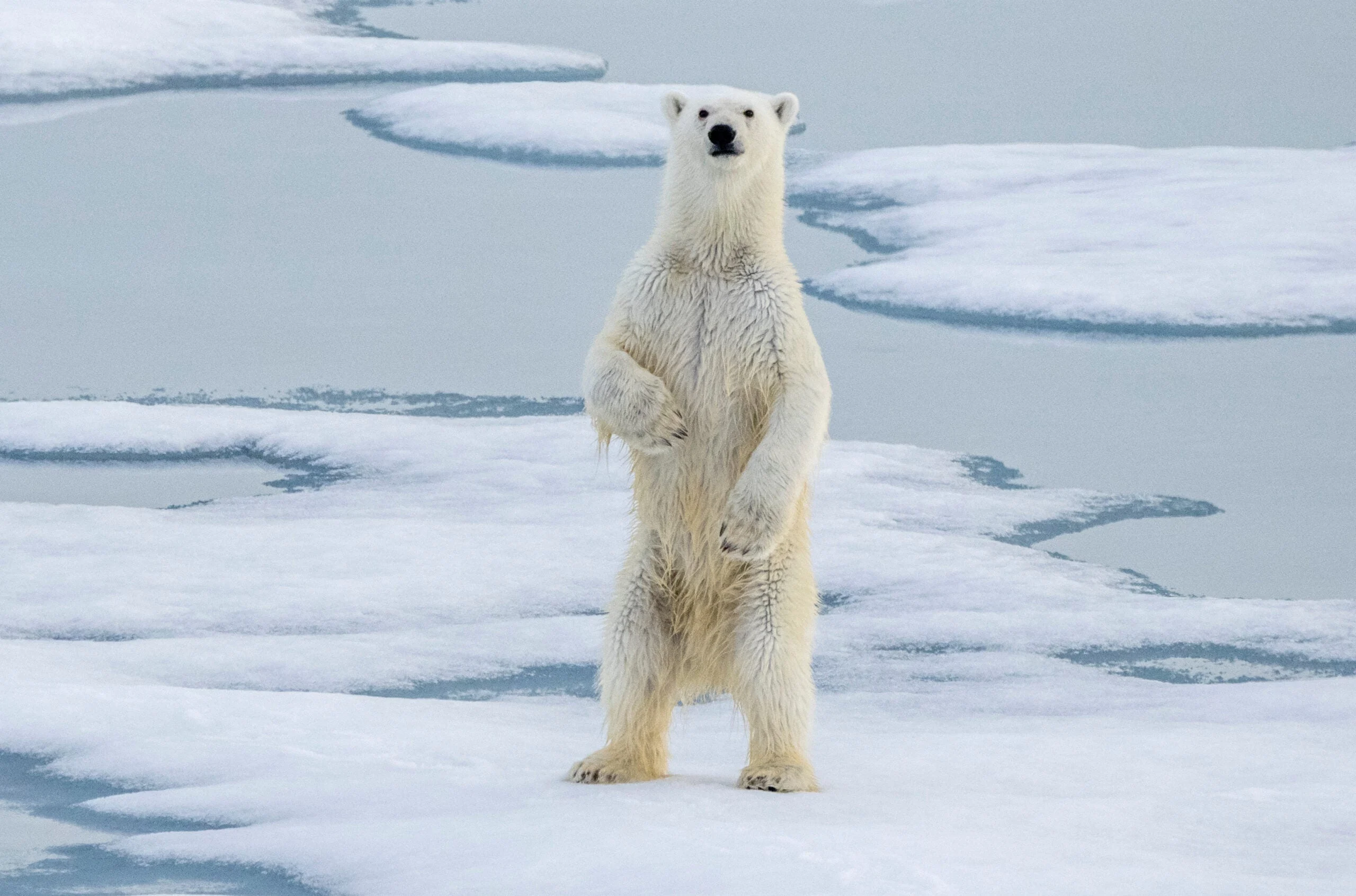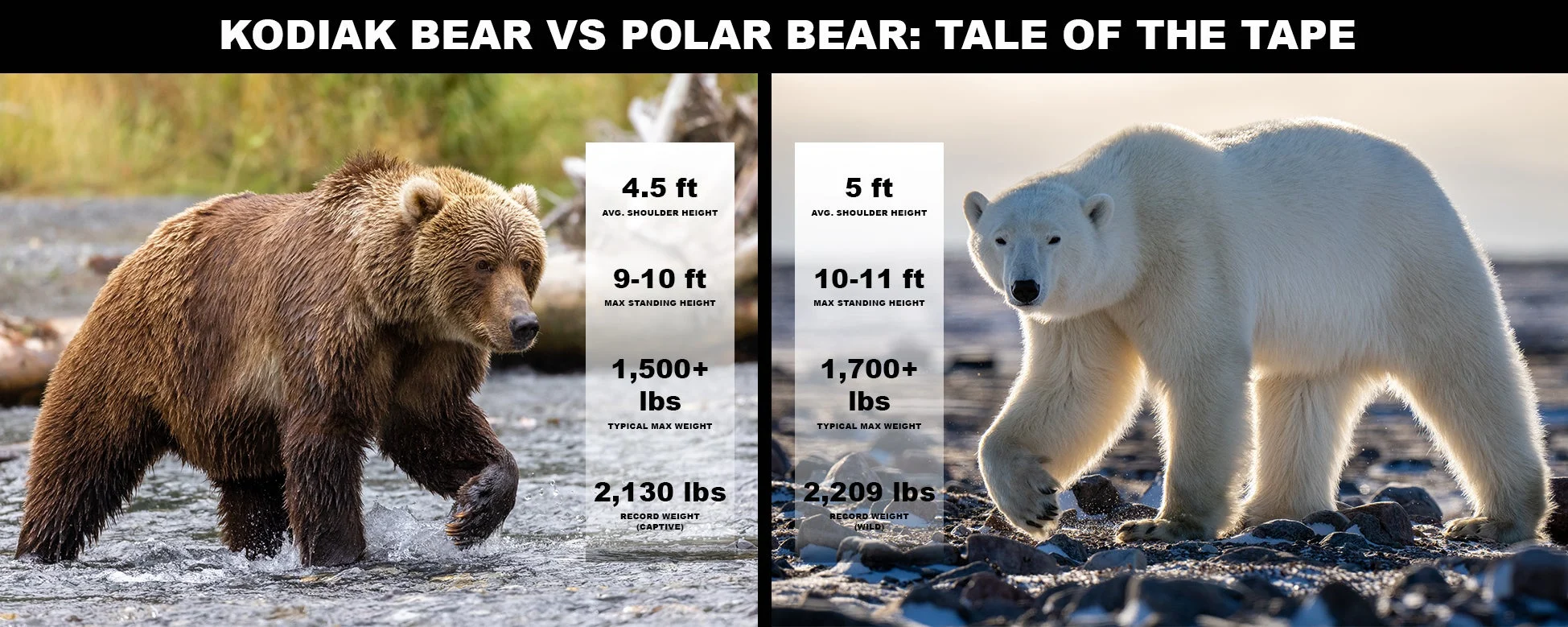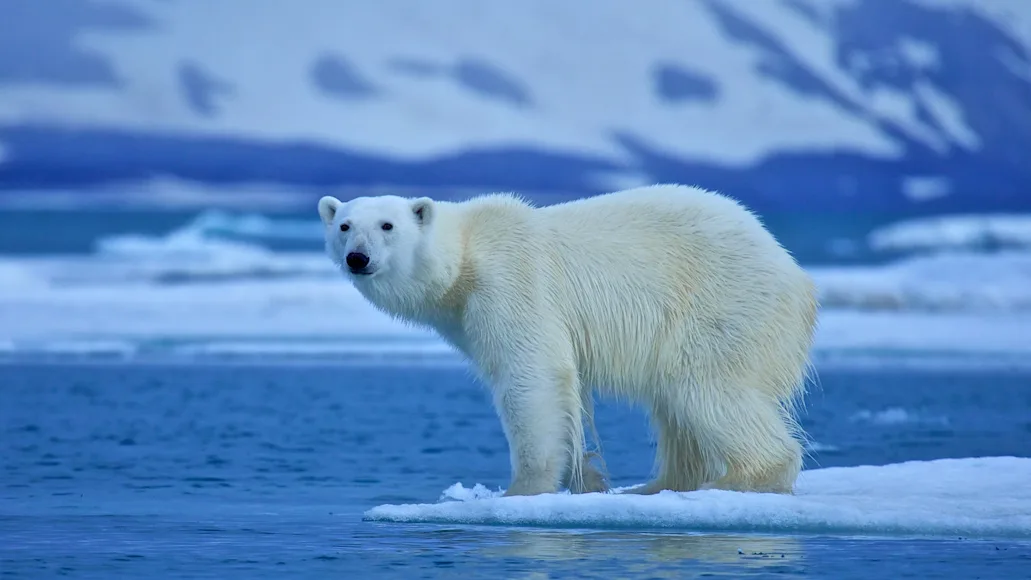Polar bears are considered the largest land-based carnivores on the planet, and they have the heft and power to take down a wide range of prey, including seals, walruses, and even the occasional reindeer or muskox. Yet, depending on how you measure or whom you ask, polar bears might not even be considered the largest species of bear. How can that be?
Well, for starters, not all bears are strict carnivores. Also, there’s more than one way to define “big.” Weight (maximum or average), height (on all fours or standing), and skull size (as measured by big-game scoring systems like the one employed by Boone and Crockett Club) can all be used to judge a bear’s size. So, given all those variables, exactly how big is a polar bear? Let’s break it down.
How Big Is a Polar Bear By Weight?
To understand how big a polar bear can get, consider that the largest polar bear ever killed is thought to be a 2,209-pound behemoth taken on Alaska’s Kotzebue Sound. An iconic photograph of the mounted bear towering over the hunter who brought it down ran in Sports Illustrated magazine in 1960, and two years later the mount featured prominently in the Alaska exhibit
at the Seattle World’s Fair.
Presumably a male, since males of the species typically get larger than females, this bear was clearly an outlier. More typically, male polar bears top out around 1,700 pounds, and females can range up to 1,000 pounds. Weight can vary greatly depending on time of year, increasing by as much as 50 percent after a successful hunting season. Average weights across the species are closer to 600 to 1,200 pounds for males and 400 to 700 pounds for females.
How Big Is a Polar Bear By Height?

A young polar bear stands tall on two feet. roberthardingrobertharding / Adobe Stock
The Kotzebue bear’s height is listed anywhere from 11-feet-1 to 12-feet-9, depending where on the interwebs you browse. Again, that bear was clearly an outlier. More commonly, polar bears stand about 5 feet high at the shoulder and measure about 7 to 8 feet long from nose to tail, although the largest males may reach 9 to 10 feet when standing on their hind legs. Like most bears, they can walk on two legs for short distances, but polar bears spend most of their time on all fours. A strolling polar bear moves about 3 miles per hour. A sprinting polar bear can achieve a speed of 25 miles per hour for short distances, which rivals that of the slowest galloping horse. Polar bears are good swimmers, too, moving faster in the water—6 miles per hour—than walking on land. They’ve been observed swimming more than 300 miles from the nearest shore.
How Big Is a Polar Bear By Skull Measurement?
The world-record polar bear, according to the Boone and Crockett Club, which uses skull length when determining if a bear qualifies for its big-game record book, was shot in 1963 by a hunter named Shelby Longoria with his guide, John Swiss. That bear also came from near Kotzebue (which has produced six of the top nine Boone and Crockett polar bears) and was taken nearly 100 miles offshore on pack ice. The skull scored 29 15/16 inches.
The B&C world record Alaska Brown Bear, by comparison, featured a skull that scored 30 12/16 inches. That raises an interesting question: How big is a polar bear compared to other bears
—especially its closest evolutionary ancestor, the brown bear.
Polar Bears vs Brown Bears

By most measurements, polar bears are a little bigger than even the biggest brown bears. Adobe Stock / Field & Stream
There is actually some disagreement on which bear species is the biggest. Alaska Brown Bears (also known as Kodiak Bears because of their concentration on the islands of the Kodiak Archipelago) are sometimes touted as the largest bear species. They can stand 10 feet tall and weigh as much as 1,500 pounds. Their widely diverse diet includes large amounts of plants like grasses and berries, which means they are classified as omnivores and aren’t a threat to steal the polar bear’s crown as largest land-based carnivore.
Some individual Kodiak bears—which are famous for loading up on salmon in the fall as they pile on weight to prepare for hibernation and vie for Fat Bear Week
honors—can rival individual polar bears in size. The largest wild brown bear on record, according to the Guinness Book of Animal Facts and Feats, weighed 1,656 pounds. A Kodiak bear named Clyde who lived at a North Dakota zoo reportedly weighed 2,130 pounds and measured 9.8 feet tall when he died in 1987 at the age of 22.
Polar bears are thought to have evolved from grizzly bears to adapt to the demands of surviving in the icy north, and they did so fairly rapidly in evolutionary time—within the last 500,000 years. The thicker skin, denser fur, and greater levels of insulating fat needed to survive in the Arctic Circle created a heavier bear, which necessitated changes in gait and foot structure to ensure safe travel on ice. To better pursue their favorite prey, seals, they developed elongated skulls (which are easier to poke through narrow holes in the ice) that, although weaker structurally than a brown bear’s skull, create a much stronger bite force
: 1,200 pounds per square inch compared to the grizzly’s 975 pounds per square inch.






